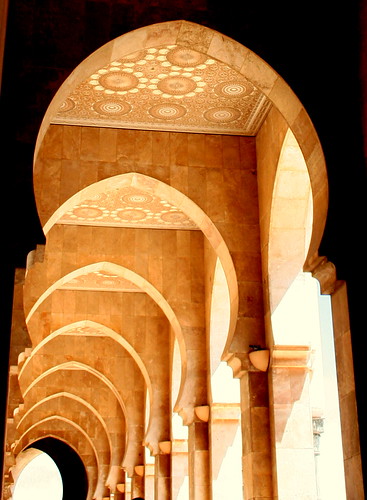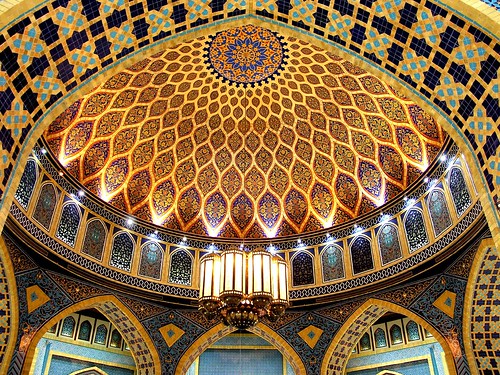Principal 3 : Architecture as Ikhlas
There are 2 ways to express submission to God:
- outward physical action
- inward action of the heart
Both of these expressions can be achieved by removing doubts and negative thoughts from the heart, and to practice deep contemplative as well as thoughtful and spiritual feelings of nature and of man. These actions can be done in the form of prayer, meditation and by ones social behavior.
Architecture with ikhlas can be translated thought the design and motifs to build within conformity to Gods will. this can be expressed by :
- space construct : the absence of human/imaginary idols are avoided
- art nonconsistant images: projecting geometric subtraction through nature and by use of mathematical equations

Most Islamic structures be it a mosque, mausoleum , palace or domestic living spaces are placed around or in the middle of a garden. This garden or courtyard represents "paradise" as that of where God is confined. It is a representation of how pure and beautiful the gardens of which he created can be.
The underlying theme of the Islamic garden is the concept of the chahar-bagh or four-fold garden. Classically, the chahar-bagh is constructed around a central pool or fountain, with four streams flowing from it, representing the four main elements of life. The Prophet Muhammad (pbuh), describing his miraculous journey to heaven, mentions four rivers: flowing with wine, milk, honey and water. The number four has an inherent symbolism reflecting the natural world. The symbolism of an Islamic garden represents a universal theme – that of the understanding of nature and the universe.
In an Islamic garden the emphases are on water and shade not surprisingly as many of the early Islamic gardens were created in hot and arid areas. Gardens in Islam, unlike the great gardens in the English tradition, are not so much places for walking in, as places of rest and quiet contemplation hence the need for a place to sit is also an important consideration. The aim is to strive towards spiritual and physical refreshment, to draw closer to God through quiet contemplation and to echo the Qur’anic phrase ‘gardens underneath which rivers flow’.
Principal 4 : Architecture as a pursuit of 'Ilm
Architecture as a pursuit of 'ilm (knowledge) is one of the most prominent forms or identification of a Islamic building other than the architectural elements. This form of architecture mainly comes from the presence of Islamic writings and verses from the Quaran in the form of Islamic calligraphy.
Calligraphy in Islam is considered to be the highest art form, not least because it represents the writing of the Divine Script. The Islamic calligrapher is the most revered of artists because his work is seen as the purest form of religious expression. Unlike much of Islamic art, which remained anonymous, calligraphy was often signed by its artist. Islamic calligraphy is an empowering and sacred form of visual expression portraying the message of the Qur’an, which was revealed in the Arabic language.
Architecture in the form of light as expression is also visible where illuminating effects of the suns rays and moonlight reveal the inscriptions and it is a moving source of nature therefore gives one a more spiritual experience of that space.
The above images portray some fine examples of islamic inscriptions which are located at the Great Mosque of Cordoba,Spain
Principal 5 : Architecture for Iqtisad
This form of architecture can be expressed in forms of:
- functional and spritual elements
- to understand nature and harmony through point of intersection
the characteristics of this principal include:
- moderation and balance which represent nature and have a profound impact on architecture
- notion of heart which relates to external facades of islamic buildings
- islamic composition for aesthetics using the golden ratio or ratio of phi
 |
| Construction of a five-to-tenfold pattern based on the golden mean proportion. |
The architecture of haya or modesty greatly represents the preservation of dignity of oneself. This can be accomplished by :
- placing Islamic buildings around a central courtyard which serves to promote environmental purposes for cooling and shelter but also different roles of the sexes.
- placing spaces at the heart of the layout and divisions within Islamic architecture so that sanctuary privacy and respect are provided.
- retaining the values of Muslims.
Modesty can be divided into 3 meanings :
- Tawado (humility)
- Ih'tesham (decency)
- Istehyah (awareness)
in representation of architecture these 3 meanings can be show as a preservation of dignity by using a screen/veil also know as the mashrabiya ,as such as the Muslim women use to as a guard to gain respect and to protect ones dignity for what others see. The screen that is used in architecture allows one to see out , however those that want to look into the structure cant do so. This screen is mainly used in spaces where privacy is required such as the separation of spaces between male and female and it also provides natural ventilation and protection from the elements. Modern screens are made of interlocking wooden rods and also provide antithetical features.
The bent entrance into a structure also represents modesty, it provides a filter and provides some form of privacy for those who are guests from the rest of the home. As for the mosque, the side entrance give the user a discreet approach before the realization of the magnificent size of the central public spaces of the mosque's courtyard.
Principal 7 : Architecture as Dikr
This principal is orientated around repetition of elements for example rhythmic precision mirrored in the contemplative chanting of God's many attributes.
The manifestation of contemplation gives a sense of unity through the rhythm and it show eternal and infinite nature of God's essence.
This is primarily show in the motifs, ornamentation, building elements and floor plan of the structure.
References
http://www.sciencedirect.com/science/article/pii/S2095263512000635#gr14
http://www.someonemuslim.com/iip/itm.php?id_top=27










No comments:
Post a Comment